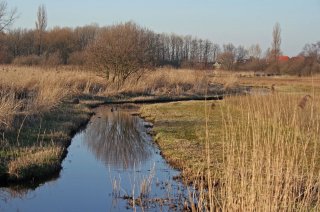
Project
The Round Landscape: Landscape-driven climate adaptation - nature-inclusive and circular
Worldwide, there is growing attention for nature-based solutions as promising solutions for climate adaptation and mitigation. At the same time, the decline in biodiversity is receiving a great deal of attention. The aim of this project is to increase biodiversity and create conditions for climate-proof biodiversity by applying nature-based solutions for climate adaptation and mitigation in urban and rural areas. In nature-based solutions, we see natural processes as leading.
By giving more space to greenery, nature and water in strategic places, both flooding and water shortage can be prevented and a habitat for plants and animals created. Instead of solving a problem with technocratic, "grey" measures, it is better to find natural, "blue and green" solutions by making use of the properties of the natural system. These solutions are potentially more sustainable, less damaging to the environment and require fewer resources. In addition, cities also become more pleasant and healthy to live in.
City and countryside in cohesion
The urban area and the surrounding rural area cannot be seen separately from each other; they are part of the same natural system. Especially when a planning area is small, such as a town or a municipality, it is important to consider the natural system and its processes at a higher level of scale. Often, challenges in the urban area can be prevented or solved by taking measures elsewhere, in the rural area.
Case studies on the high sandy soils
In the Round Landscape project, we are investigating how landscape- and nature-based solutions can be found and incorporated into a vision of the future in an area process. We are investigating how landscape- and nature-based solutions influence policy and planning processes and what contribution such a vision makes to the transition in an area. We do this in a number of case studies, each with its own scale. These case studies consist of assignments from regional authorities (municipalities, provinces, water boards) that have approached us in response to the vision "A natural future for the Netherlands in 2120", with the request to also develop a natural vision for their area.
In the Round Landscape, we focus on the high sandy soils. In this part of the Netherlands, knowledge of the basic natural system at a higher level of scale is crucial for finding integrated solutions because of the height differences in the area. Many cities on the high sandy ground are located at the lower reaches of brooks. Solutions for e.g. flooding in these cities can be found in higher areas upstream.
Examining the role of vision development in area transition
In this project, we are investigating whether and how the landscape systems approach, as applied in the Round Landscape, contributes to the transition to a biodiverse, circular and climate-neutral society. We are doing this by interactively and reflexively contributing to the policy and administrative processes in case areas.
As researchers, we participate in the processes in the cases and examine what the role and impact of design-based research can be to initiate the envisaged transition.
We analyse and evaluate the process in the cases in terms of existing transition models. We investigate how developments in existing technical, social and conceptual systems and concrete renewal initiatives relate to each other.